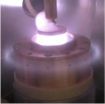(Press-News.org) Experiments on the DIII-D tokamak that General Atomics operates for the U.S. Department of Energy (DOE) have demonstrated the ability of lithium injections to transiently double the temperature and pressure at the edge of the plasma and delay the onset of instabilities and other transients. Researchers conducted the experiments using a lithium- injection device developed at the DOE's Princeton Plasma Physics Laboratory (PPPL).
Lithium can play an important role in controlling the edge region and hence the evolution of the entire plasma. For example, researchers have used lithium on the National Spherical Torus Experiment (NSTX) at PPPL and the EAST tokamak in China to improve the performance of the plasma. When lithium is injected, the boundary of the plasma emits green light, characteristic of lithium atomic processes (see figure to the right).
In the present work reported in a number of papers at the 56th American Physical Society Division of Plasma Physics Conference, New Orleans, LA, Oct. 27-31, 2014 [1], lithium diminished the frequency of instabilities known as "edge localized modes" (ELMs), which have associated heat pulses that can damage the section of the wall that is used to exhaust heat in fusion devices. The experiments injected lithium powder at low velocity from the top of DIII-D during plasma discharges, and compared the results with previous discharges done without lithium. DIII-D is optimally suited for this work since no lithium was previously present before these experiments, and world-class diagnostics on the device enabled careful evaluation of the direct effect of the lithium.
The tailored injections produced ELM-free periods of up to 0.35 seconds, while reference discharges without lithium showed no ELM free periods above 0.03 sec. The lithium rapidly increased the width of the pedestal region — the edge of the plasma where temperature drops off sharply — by up to 100 percent and raised the electron pressure and total pressure in the edge by up to 100 percent and 60 percent respectively. These dramatic effects produced a 60 percent increase in total energy-confinement time. Further work will focus on extending these high-performance ELM-free phases and uncovering the mechanisms by which lithium calms the plasma.
INFORMATION:
This material is based upon work supported by the U.S. Department of Energy, Office of Science, Office of Fusion Energy Sciences, using the DIII-D National Fusion Facility, a DOE Office of Science user facility, under Awards DE-FC02-04ER54698 and DE-AC02-09CH11466.
[1] G.L. Jackson, et al., 56th APS DPP conference, Oct. 27-31, 2014, paper CO5.09;
R. Maingi, et al., 56th APS DPP conference, Oct. 27-31, 2014, paper GP8.36;
T.H. Osborne, et al., 56th APS DPP conference, Oct. 27-31, 2014, paper GP8.37;
Z. Yan, et al., 56th APS DPP conference, Oct. 27-31, 2014, paper GP8.38
S.L. Allen, et al., 56th APS DPP conference, Oct. 27-31, 2014, paper CO5.06
Calming the plasma edge: The tail that wags the dog
News from the 2014 APS Division of Plasma Physics Meeting
2014-10-28
ELSE PRESS RELEASES FROM THIS DATE:
Remnants of tropical depression soaking Central America
2014-10-28
NASA's Terra satellite passed over Tropical Storm Hanna on Oct. 27 when it made landfall near the northern Nicaragua and southern Honduras border.
On Oct. 27 at 16:00 UTC (12 p.m. EDT) the MODIS instrument aboard NASA's Terra satellite captured a visible image of Tropical Storm Hanna straddling the border between Honduras and Nicaragua. The image, created by NASA's MODIS Rapid Response Team at NASA's Goddard Space Flight Center in Greenbelt, Maryland, showed strong thunderstorms on both sides of the border, bringing heavy rainfall to those area.
At 10 a.m. EDT on Oct. ...
New study uses DNA sequences to look back in time at key events in plant evolution
2014-10-28
Scientists from North America, Europe and China have published a paper in the Proceedings of the National Academy of Sciences that reveals important details about key transitions in the evolution of plant life on our planet.
From strange and exotic algae, mosses, ferns, trees and flowers growing deep in steamy rainforests to the grains and vegetables we eat and the ornamental plants adorning our homes, all plant life on Earth shares over a billion years of history.
"Our study generated DNA sequences from a vast number of distantly related plants, and we developed new ...
Ana's remnants raining and gusting in British Columbia, Canada
2014-10-28
NOAA's GOES-West satellite captured an image of post-tropical cyclone Ana's remnant clouds raining on British Columbia, Canada today, Oct. 28. Wind warnings along some coastal sections of British Columbia continued today as the storm moved through the region.
NOAA's GOES-West satellite gathered infrared data on Ana's remnant clouds and that data was made into an image by NASA/NOAA's GOES Project at NASA's Goddard Space Flight Center in Greenbelt, Maryland. In the image the remnant clouds resemble a frontal system.
Environment Canada's Meteorological Service continued ...
Breathe easier: Get your D
2014-10-28
Asthma, which inflames and narrows the airways, has become more common in recent years. While there is no known cure, asthma can be managed with medication and by avoiding allergens and other triggers. A new study by a Tel Aviv University researcher points to a convenient, free way to manage acute asthmatic episodes — catching some rays outside.
According to a paper recently published in the journal Allergy, measuring and, if need be, boosting Vitamin D levels could help manage asthma attacks. The research, conducted by Dr. Ronit Confino-Cohen of TAU's Sackler Faculty ...
Using radio waves to control the density in a fusion plasma
2014-10-28
Recent fusion experiments on the DIII-D tokamak at General Atomics (San Diego) and the Alcator C-Mod tokamak at MIT (Cambridge, Massachusetts), show that beaming microwaves into the center of the plasma can be used to control the density in the center of the plasma, where a fusion reactor would produce most of its power. Several megawatts of microwaves mimic the way fusion reactions would supply heat to plasma electrons to keep the "fusion burn" going.
The new experiments reveal that turbulent density fluctuations in the inner core intensify when most of the heat goes ...
Helping general electric upgrade the US power grid
2014-10-28
When researchers at General Electric Co. sought help in designing a plasma-based power switch, they turned to the U.S. Department of Energy's (DOE) Princeton Plasma Physics Laboratory (PPPL). The proposed switch, which GE is developing under contract with the DOE's Advanced Research Projects Agency-Energy, could contribute to a more advanced and reliable electric grid and help to lower utility bills.
The switch would consist of a plasma-filled tube that turns current on and off in systems that convert the direct current (DC) coming from long-distance power lines to the ...
European consensus on methodological recommendations for clinical studies in rare cancers
2014-10-28
One out of every five new cancer patients is diagnosed with a rare cancer, yet the clinical evidence needed to effectively treat these rare cancer patients is scarce. Indeed, conventional cancer clinical trial methodologies require large numbers of patients who are difficult to accrue in the situation of rare cancers. Consequently, building clinical evidence for the treatment of rare cancers is more difficult than it is for frequent cancers.
Dr. Jan Bogaerts, EORTC Methodology Vice Director, points out, "For rare cancers, we need alternative ways to conceive study designs ...
Lack of A level maths leading to fewer female economists
2014-10-28
A study by the University of Southampton has found there are far fewer women studying economics than men, with women accounting for just 27 per cent of economics students, despite them making up 57 per cent of the undergraduate population in UK universities.
The findings suggest less than half as many girls (1.2 per cent) as boys (3.8 percent) apply to study economics at university, while only 10 per cent of females enrol at university with an A level in maths, compared to 19 per cent of males.
"This underrepresentation of women economics degrees could have major implications ...
Physicists' simple solution for quantum technology challenge
2014-10-28
A solution to one of the key challenges in the development of quantum technologies has been proposed by University of Sussex physicists.
In a paper published today (28 October) in Nature Communications, Professor Barry Garraway and colleagues show how to make a new type of flexibly designed microscopic trap for atoms.
Quantum technology devices, such as high-precision sensors and specialised superfast computers, often depend on harnessing the delicate interaction of atoms. But the methods for trapping these tiny particles are hugely problematic because of the atoms' ...
Technique uses bacteria's own CRISPR-Cas system to turn off gene
2014-10-28
Researchers from North Carolina State University have developed a technique that co-opts an immune system already present in bacteria and archaea to turn off specific genes or sets of genes – creating a powerful tool for future research on genetics and related fields.
"This should not only expedite scientific discovery, but help us better engineer microbial organisms to further biotechnology and medicine," says Dr. Chase Beisel, an assistant professor of chemical and biomolecular engineering at NC State and senior author of a paper on the work. "For example, this ...
LAST 30 PRESS RELEASES:
Norbert Holtkamp appointed director of Fermi National Accelerator Laboratory
New agentic AI platform accelerates advanced optics design
Biologists discover neurons use physical signals — not electricity — to stabilize communication
Researchers discover that a hormone can access the brain by hitchhiking
University of Oklahoma researcher awarded funding to pursue AI-powered material design
Exploring how the visual system recovers following injury
Support for parents with infants at pediatric check-ups leads to better reading and math skills in elementary school
Kids’ behavioral health is a growing share of family health costs
Day & night: Cancer disrupts the brain’s natural rhythm
COVID-19 vaccination significantly reduces risk to pregnant women and baby
The role of vaccination in maternal and perinatal outcomes associated with COVID-19 in pregnancy
Mayo Clinic smartwatch system helps parents shorten and defuse children's severe tantrums early
Behavioral health spending spikes to 40% of all children’s health expenditures, nearly doubling in a decade
Digital cognitive behavioral treatment for generalized anxiety disorder
Expenditures for pediatric behavioral health care over time and estimated family financial burden
Air conditioning in nursing homes and mortality during extreme heat
The Alps to lose a record number of glaciers in the next decade
What makes a good proton conductor?
New science reporting guide published for journalists in Bulgaria
New international study reveals major survival gaps among children with cancer
New science reporting guide published for journalists in Turkey
Scientists develop a smarter mRNA therapy that knows which cells to target
Neuroanatomy-informed brain–machine hybrid intelligence for robust acoustic target detection
Eight SwRI hydrogen projects funded by ENERGYWERX
The Lundquist Institute and its start-up company Vitalex Biosciences Announces Strategic Advancement of Second-Generation fungal Vaccine VXV-01 through Phase 1 Trials under $40 Million Competitive Con
Fine particles in pollution are associated with early signs of autoimmune disease
Review article | Towards a Global Ground-Based Earth Observatory (GGBEO): Leveraging existing systems and networks
Penn and UMich create world’s smallest programmable, autonomous robots
Cleveland researchers launch first major study to address ‘hidden performance killer’ in athletes
To connect across politics, try saying what you oppose
[Press-News.org] Calming the plasma edge: The tail that wags the dogNews from the 2014 APS Division of Plasma Physics Meeting




